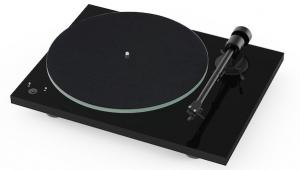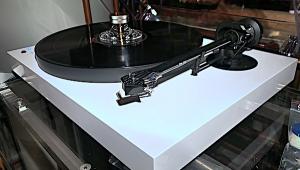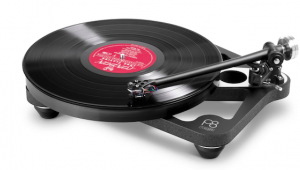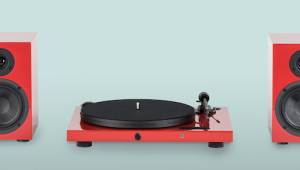SME Model 30/2 turntable

So many fanciful pieces of acrylic eye-candy are designed to appeal first to the visual sense, and so many have design "features" that simply don't make technical sense. But this impressively hunk of black metal is not the turntable to impress your friends with—until you play a record on it. The no-nonsense SME 30/2 is, as Rockport's Andy Payor describes a turntable's true role, a genuine "reverse machine tool."
From Crate to Playback in Minutes
Weighing 94 lbs, the SME 30/2 comes packed in an industrial strength wooden crate designed for rough handling and easy opening. Unless you've been pumping iron, lifting this turntable out of its box is a two-man operation. Place it on a sturdy stand and you're 15 minutes or so from your first spin (not counting arm and cartridge setup).
First, you inject (with the supplied syringe) a pre-measured charge of oil into a pre-fitted adapter located at the base of the bearing. You then unscrew and save the adapter. Then, all that's left to do is unlock the four suspension towers using the supplied ball-ended wrench, unscrew the motor transit screw using the supplied tool, adjust the motor-height screws using another supplied tool and height adjustment gauge, unlock the main bearing, fit the drive belt and platter, and, finally, level the base via the four threaded feet (a spirit level is built in). At this point you're ready to install an SME tonearm, using the supplied mounting plinth of solid brass, or a plinth appropriately drilled for your choice of arm.
All of these preparatory maneuvers reinforce the precision engineering and design acumen that went into the 30/2's construction. The machining quality of the proprietary setup tools and the smoothness and unfailing certainty with which the various locking screws rotate in their threaded sockets—not to mention the feel of the unlocking mechanisms—enhanced my confidence that the buyer's money will be well-spent. The 30/2 is an heirloom product meant to be enjoyed and passed down from generation to generation.
Once the arm plinth has been secured with the four supplied socket-cap screws, all that's left to do is adjust the height of the suspended subchassis, fit the motor-controller cord to the chassis-mounted DIN jack, and plug the unit into the AC. There's no fiddling with setup, and the few adjustments that need to be made have a certainty about them that won't leave you feeling the need to tweak.
Design Rationale
High mass, compactness, and stiffness combine to reduce flexing and vibrating—two things you don't want a plinth to do. The SME 30/2's base of 5/8"-thick aluminum alloy (plus support pillars) and its ¾"-thick suspended subchassis weigh 38 and 35 lbs, respectively, with approximate dimensions of 17.75" wide by 13.75" deep—truly, a compact disc player! An additional bar of aluminum alloy runs the length of the subchassis at about a third of its width for additional stiffness and mass. A damping layer appears to have been added to all surfaces, further reducing the amplitude and Q of whatever vibrational modes remain. Tapping on any of the surfaces yielded a short, lifeless, colorless thup.
Designing a suspended subchassis that will operate at the effectively low resonant frequency of 3Hz that's necessary for true isolation is fraught with difficulties. SOTA and Rockport tried this, and both companies' results were equally problematic. On some SOTA models, the spring-hung subchassis oscillated like a porch glider when the arm's mass would shift back and forth due to record eccentricities. Ditto the air-suspended Rockport Capella, which I reviewed years ago for The Abso!ute Sound. The motors of both 'tables were hard-mounted to their bases; when the subchassis was horizontally deflected, the platter-to-motor pulley distance would vary, causing speed irregularities. On the Rockport, the problem was exacerbated due to the linear-tracking tonearm's relatively high horizontal mass. Fitting the SOTA with an Eminent Technology arm (a popular combo in the early 1990s), with its moving rail and thus even higher horizontal mass, created an even bigger deflection—but even a pivoted arm caused movement.
SME's solution to the "porch glider" effect was to hang the subchassis on 48 specially made O-rings (12 per tower), for a total of 96 strands, in combination with damping systems of a paddle in thick fluid: one damping system per tower. Should you need to replace the O-rings (not likely, unless buying the 'table causes a divorce and your soon-to-be-ex takes a box-cutter to them), it can be done almost instantaneously—even while a record is playing, according to SME. The damping system all but eliminates horizontal deflection, while the adjustability of the degree of damping lets the user adjust the system to various conditions of acoustical and floor-borne feedback.




















































